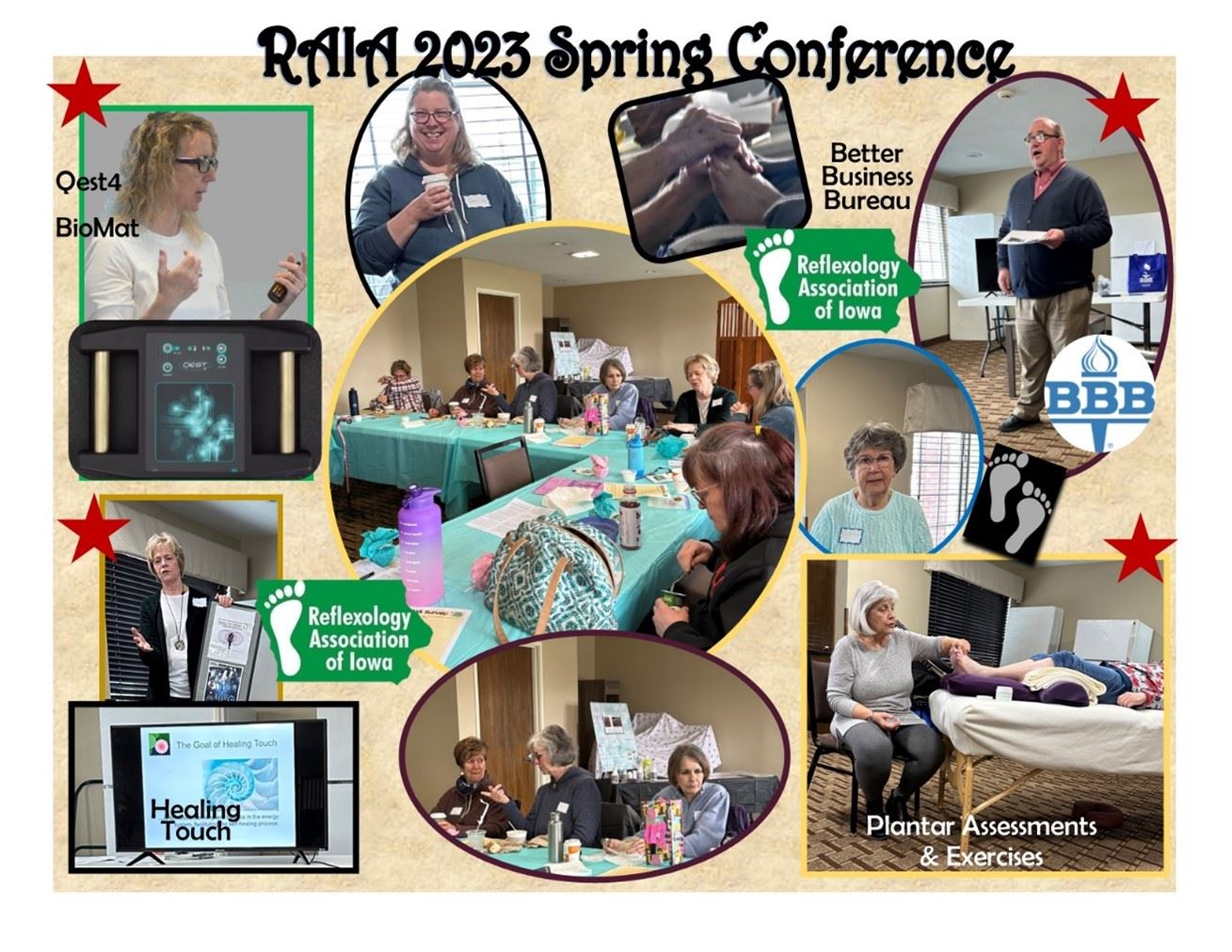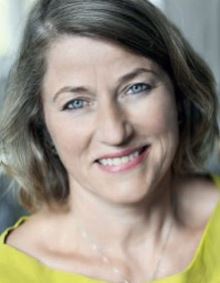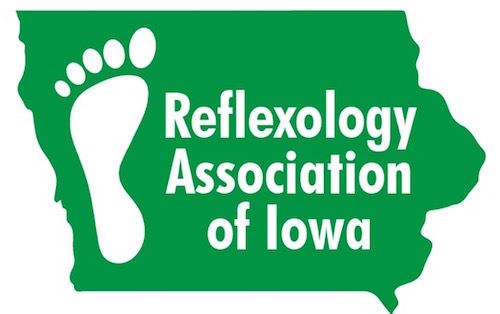| Your State Association of Professional Reflexologists |
RAIA Fall Conference 2023

__________________________________________________________________
RAIA Spring Conference 2023
The Iowa Reflexology Association held our RAIA 2023 Spring Conference last weekend April 21st-April 23rd ,2023. and what a great time we had. It was a busy weekend full of fun and learning and new experiences. We got to see old friends and make some new ones also.
Friday evening April 21st, we had Becci Rentschler offer us demonstrations on the Qest4 and BioMat for anyone that would like to try them, and Becci had several that did just that. We are all fascinated by the operations of the Qest4. It is truly an amazing machine of highly advanced technology. Being able to scan our bodies and tell us where are bodies might be lacking in vitamins, nutrients, etc. Becci was one of our Speakers Saturday and went into more detail about this unique tool. The Qest4 bioenergetic testing system is loaded with a library of over 40,000 homeopathic, nutritional, herbal, and environmental items. Which this can be offered to the clients and assist them in feeling better and balancing their bodies.
There are over 50 preloaded tests in the software, that include the majority of what any practitioner needs. It does take schooling to learn how to use the Qest4. But I believe it to be a valuable tool in the business. Thank you to Becci Rentschler.
We then finished out the evening with Free Reflexology Exchanges before getting ready to start our full day on Saturday the 22nd. Our Saturday started off with Becci as stated earlier, then a quick lunch where we sat and visited. The time went too fast.
We then welcomed our next Guest Speaker which was Chris Coleman, President of the Iowa Better Business Bureau, giving us some great tips on how to protect ourselves and our businesses from scams. Yes, they do scam businesses too, not just personal. He gave us very good information and it was amazing at how these people work to make it sound so promising and so true. Chris told us the main thing to remember is, that they will try to rephrase, remarket it only it is the same thing as they tried to scam you with before. Some tips that Chris suggested to paying attention to were:
1. If they try to hurry you into a decision.
2. If they want you to purchase a Gift Card from say: Walmart, Menards, any place that offers them.
3. Don’t give them personal information, such as your Social Security number, your Banking information, etc.
Best of all, just delete emails you are not familiar with, when receiving a letter that looks fake, contact that company to make sure it is not from them, and just don’t answer phone calls with numbers that you do not know. Because they do use, email addresses, phone numbers, and letters that they can scan and copy letterheads that look very real. These all can be bought for a cheap price from companies that don’t know themselves these are scammers. They will even use a fake invoice, so please watch out for these things and protect yourself and your business. Thank you, Chris for your very helpful information.
After Chris had completed his program, we took a quick break and then got ready for the RAIA’s Board Meeting. Joye Meyer, Treasurer, read the annual report, and spoke of when the annual RAIA dues would be coming up.
Renita Murrell, President, spoke of new business with RAIA, the RAA election, membership letters.
Jamie Lynn Thompson, Legislation for RAIA, spoke of Human Trafficking and what she has been working on to help Reflexology be out of the sight of law enforcement. Jamie has been going to or calling many City Councils, and discussing with them the regulations that Reflexology has to prevent such a tragic ordeal. Helping them to understand what Human Trafficking is all about and that it can happen anywhere, not just in bigger cities. She is working diligently to make it clear that Reflexology is not involved in Human Trafficking.
Amy S. Petersen then presented what ARCB is working on at this time with webinars coming up to improve on the testing for the ARCB exam. Making it available for anyone no matter their study level. She explained the process of what this company is doing to help ARCB make this exam work for the benefit of all who would like to take it. Updating the material in the questions, and more overall variety of questions, so that all areas of Reflexology will be covered. But it is a process. It is research that will assist in making this exam exactly what needs to be improved upon and we applaud Tish for taking on such a big task (Tish is the President of ARCB).
After the RAIA Board meeting we then proceeded on with Healing Touch by our own Joye Meyer, who is an instructor and in her own business does Healing Touch. She had a mentee with her (Tayler Rajtora) who presented with Joye to earn her hours and do her Community Service work. Healing Touch is an energy therapy in which practitioners use their hands to enhance and balance the physical, emotional, and spiritual well-being of their clients. Joye and Taylor explained that Healing Touch is used to be calming, decrease pain, create a sense of well-being, ease chronic and acute conditions and much to help the body restore harmony. Joye and Tayler also work with Healing Touch Beyond Borders. Going out and helping others around the country to experience this overall sense of healing and balance. We thank them for a very interesting Presentation and we had plenty of questions. Thank you, Joye, for your wonderful Presentation and explaining to us what Healing Touch does.
That was the end of our day Saturday, after a nice dinner, some returned to do Free exchanges which earned them more CE’s.
Sunday morning, we welcomed Amy S. Petersen as our Presenter. She spoke on Plantar Assessment & Exercises. She had a volunteer to demonstrate to us the areas that need to be worked on to help with Plantar Pain. The demonstration was very powerful information, it resonated with all of us, because we all have so many clients with this type of pain. Thank you, Amy for your knowledge. And thank you Barb for being the volunteer!
After Amy it was time to do more exchanges and the closing of a wonderful conference.
I want to thank the RAIA Board for assisting me in putting the Conference together. I thought it was a great success and very informative. It was a calming and peaceful atmosphere, while learning. And I want to say a big thank you to our Presenters.
We are already looking forward to our Fall Meeting. I just want to say that we have a great group of members. We value each and every one, we enjoy being together and welcome new members as well.
If you are without an Association, contact me and I will send you any information you need to join us here in Iowa. We are small but a mighty group!
Renita Murrell, President of RAIA

_______________________________________________________________________________________________________________
October 2019 by Linda Schroeder
Iowa----RAIA
T o u c h p o i n t
Round About: The Immune System
RAIA Fall Conference 2019
Presenters: Dorthe Krogsgaard and Peter Lund Frandsen from Denmark
Dates: October 5 & 6, 2019


The Iowa Reflexology Association welcomed Dorthe Krogsgaard and Peter Lund Frandsen from Denmark to Cedar Rapids, Iowa in October. There were twenty-two attendees from the Midwest part of the country, eager to learn about the physiology aspect of the Immune System.
As we may know the immune system is our defense against infections and foreign substances and at the same time an integral part of the self-healing and self-balancing system.
It is the immune system that maintains and repairs the body by being able to distinguish between self and non-self, between internal and external. It sets the boundaries; removes damaged or worn out cells and helps building new tissue after injury. The nonspecific immune system (innate): Passive as in surfaces, skin (low pH), mucous membranes of respiratory tract, and mucous membranes of the digestive system (low pH in the stomach, microbiota). Active as in Phagocytes (neutrophils, macrophages and the compliment system).
The lymphatic vessels are found in the connective tissues. Their walls are soft and collapse easily, so blockages in the connective tissue or muscle tensions may decrease flow of lymph.
New hypothesis of chronic inflammation. As part of the inflammation process neutrophils release a cascade of oxidative chemicals that break down bacteria and damaged cells. These are positively charged free radicals, which are highly chemically reactive because they lack one or more electrons. Some of the surrounding healthy tissue may also be affected and the decomposition material may then coagulate and form a barricade around the site of inflammation. This barricade prevents antioxidants and regenerative cells to reach the repair site. Healing is not complete, and the immune system continues to try to repair. This is the beginning of a vicious cycle, which can lead to chronic inflammation. With heat, redness swelling, pain and loss of function.
Good antioxidants from whole foods and a colorful plate of food!! Vitamin D is a must. The vicious circle can be prevented by ensuring supply of antioxidants (various negatively charged ions, ultimately free electrons) that can keep the process under control so as to avoid damage to the surrounding tissue and the formation of the inflammatory barricade. Inflammation is necessary but the communication is mixed. The body needs to break down the inflammation.
Question: Where is the largest concentration of lymph nodes in the body found? Not the neck, lungs nor central abdominals, but the superior mesenteric artery at the level of the head of pancreas and the duodenum.
To mention that the thymus, spleen, liver, adrenal glands are other immune organs. Does the adult thymus play a role? It is reduced in adults and it has a negligible importance after puberty. Others believe the thymus can be seen as and “immune university and library” which educates immune cells and store information about antigens and most of the “basic training” takes place in childhood it may maintain an important function throughout life. Part of theory is during fetal stages in the womb, what was going on in the mother’s life and back generations.
Touching on topics such as Potential effects on the immune system
Massage, touch, heart coherence: Pro-inflammatory verses Anti-inflammatory
Stress, Diet, Microbiota, Thoughts/Emotions, Metabolism, Exercise, Holistic Therapies, Earthing.
Peter and Dorthe spent a great deal of time demonstrating each protocol for implementing the various techniques in Touch Point Immune System. One thing of importance, having client awake thru session, while giving feedback to therapist.
To Relax the autonomic nervous system, we use an energy technique, where we gently touch the reflexes. It is an advantage only to touch the skin where you want the body to focus the energy, finding a comfortable position so you can maintain a stationary grip for up to a few minutes. The duration in individual and depends on an intuitive assessment and feedback from the client.
Bilateral energy technique: Sympathetic (T1-L2) Parasympathetic: (Brain stem-C3)
Parasympathetic (S2-S4);
Unilateral energy technique: Sympathetic (T1-L2), Parasympathetic (Brain stem and sacrum).
We discovered the Spleen and liver on the lower leg. From the Karl-Axel Lind method system. The entire body is reflected in the lower legs and feet. The reflection is upside down, so the feet reflect the head and the body is located up the lower leg. Reflexes for the Vagus Nerve is a cranial nerve originating in the brainstem and takes a long course through the neck, thorax and abdomen. Recently discovered, that 80-90% of the neurons in the nerve are so called visceral afferents, meaning they convey sensory information from the inner organs to the brain.
I found it to be refreshing as Dorthe revisited the Resonance techniques, which also was demonstrated, at the last conference in Chicago. The idea is to find the power and rhythm which fits into the client’s vibration pattern. You will get information from the body: Does it move freely? Is IT STAGNATED? Is one side more rigid than the other? This technique stimulates the communication between body cells and can help release congested or stagnated energy.

At the end of the weekend our focus was on Earthing and how this can be an effective way to regulate inflammation processes in a simple way as grounding. Taking at least a half an hour every day as a positive effect on the course of inflammation and tissue repair. I love to go barefoot on the ‘earth’ until it gets just too cold, like now in Iowa. Tour de France cyclists use “recovery bags” to speed up healing of injuries and overused muscles.
For me it is always hard to see a class end, but let’s not forget the Immune System big picture and how our eating habits plays a role in the Anti- inflammatory nutrition and suggestions that one can use for an anti-inflammatory diet. Mia Damhus, a Nutritional therapist DET shares with us to eat fish or take supplements of fish oils; cut down on meat from four legged animals and all animal fat; eat small healthy in-between meal morning and afternoon; Avoid: sugar and artificial sweeteners, white bread, white pasta and white rice, milk, caffeinated beverages (teas in moderate amount is OK; Take supplements of probiotics (good bacteria) daily; use freshly grated raw ginger in tea, dressings and for cooking and add 1 tsp turmeric daily and drink enough water daily.
Supplements: strong multi vitamin, D vitamin 35-70 mcg, probiotics 1 tsp daily,
C vitamin 1500- 3,000 mg, N-3 fatty acids (fish oil), flaxseed 1-2 tblsp daily
There was a lot of information passed during this class, which I know it was received with gratitude and will be implementing techniques to each of our toolboxes. Everyone is the class shared giving and receiving techniques that were mirrored to us by Peter and Dorthe.
It was a pleasure having these two wonderful instructors/teachers in our community, which reflects Reflexology therapists sharing the knowledge which in turn is power. I hope one day I can attend one of their classes in Denmark!!
If you would like to know more about Touch Point Round About: The Immune System you can go to www.touchpoint.dk

_________________________________________________________________________________________
RAIA Conference in Chicago (April 2018)

RAIA Conference in Chicago (April 2018)
Back Row (L-R): Donna Jones, Karen Hageman, Kim Lande, Dorothy Hartman, Joye Meyer, Barb Duwe-Peterson, Janet Latchaw, Natalie Anderson, Pat Barrance
Front row: Linda Schroeder, Amy Petersen
